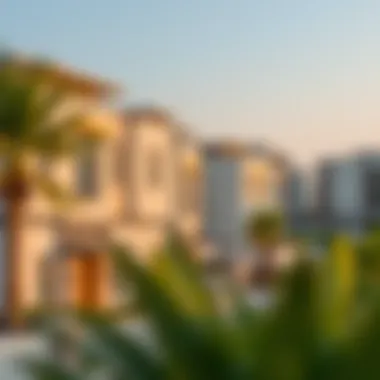Sheikh Zayed Housing Programme: Overview and Impact


Intro
The Sheikh Zayed Housing Programme has emerged as a pivotal solution for countless families in the United Arab Emirates, especially for Emirati citizens striving for affordable housing. As the population continues to grow and urban development accelerates, the strain on the housing market intensifies. This initiative, born out of a need for social welfare, aims to ensure that citizens can secure their own homes without breaking the bank. By analyzing its objectives and implications, we can gain a better grasp of the fundamental shifts in the housing landscape.
Market Insights
Current Market Trends
In recent years, there's been a noticeable rise in property developments driven not just by demand but also by regulatory support aimed at enhancing affordability. The Sheikh Zayed Housing Programme plays a crucial role within this framework, as it addresses the pressing need for housing among UAE nationals. According to recent data, housing prices have started to stabilize after fluctuations observed during the pandemic period. There’s an increasing trend towards more sustainable and eco-friendly housing solutions, as families begin to prioritize energy efficiency and environmental responsibility in their home choices.
"The housing market in the UAE is evolving, reflecting changing societal needs, and the Sheikh Zayed Programme is at the forefront of this evolution."
Economic Factors Influencing Prices
Several economic factors have a hand in shaping the housing market in the UAE. A thriving economy typically leads to increased disposable income, allowing more individuals to consider home purchase rather than renting. Additionally, government regulations, such as those enforced by the Sheikh Zayed Housing Programme, aim to facilitate access to affordable housing options. As foreign investment in real estate continues to ebb and flow, local dynamics are often left to dictate the pace and nature of property prices. Factors like interest rates and consumer sentiment can dramatically influence purchasing decisions, affecting how the general public engages with the housing market.
Investment Opportunities
High-Yield Neighborhoods
Investors looking for lucrative opportunities cannot overlook the areas thriving under the influence of the Sheikh Zayed Housing Programme. Communities that have recently benefitted include Al Ain and Sharjah, where government focus has escalated home construction. Trends suggest that these neighborhoods are not only attracting families but also younger professionals seeking affordable living solutions away from the urban hustle. Investing in these emerging markets can yield high returns as home values increase.
Property Types for Investment
The diversity of housing options makes the Sheikh Zayed Housing Programme a fertile ground for investment. Types of properties available range from villas to apartments, catering to various demographics. Some attractive options include:
- Affordable Villas: Often preferred by larger families, these homes offer space and comfort without exorbitant price tags.
- Modern Apartments: Ideal for singles and couples, these properties are in high demand and often feature modern amenities.
- Mixed-Use Developments: These not only serve as residential spaces but also include retail and commercial areas, ensuring a vibrant community.
Understanding these options can significantly enhance an investor's prospects in capturing market demand efficiently.
Intro to the Sheikh Zayed Housing Programme
The Sheikh Zayed Housing Programme stands as a pivotal undertaking in the realm of housing within the United Arab Emirates. As housing costs continue to rise in urban areas, disparities in housing access remain a pressing concern. This programme aims to address this gap, making it not only relevant but essential for UAE citizens seeking affordable and sustainable living solutions.
The significance of the Sheikh Zayed Housing Programme can be traced back to its foundational goals. Designed with the intent to provide housing support, it caters primarily to Emiratis, encouraging community integration and stability. This initiative is geared towards enhancing the quality of life for its beneficiaries, ensuring that they have access to decent housing that fosters a sense of belonging.
Moreover, this programme also plays a crucial role in shaping the landscape of real estate in the UAE. As the nation continues to develop, understanding the effects of such initiatives can offer insights into broader housing market trends and shifts.
In this article, we will delve into various aspects of the Sheikh Zayed Housing Programme. The examination will include its historical context, purpose, and specific goals. By exploring these dimensions, readers will gain a comprehensive understanding of how this initiative fits within the larger societal framework.
"A home is more than just a roof over one’s head; it’s a foundation for building dreams and futures."
Through this thorough overview, we will not only highlight the benefits of the programme but also consider its implications on community cohesion and economic stability in the UAE.
Program Structure and Funding
The framework and funding of the Sheikh Zayed Housing Programme are pivotal in shaping its effectiveness and sustainability. Since its launch, the programme has become a bedrock for addressing housing needs in the UAE, representing not just a collection of projects, but a comprehensive strategy to empower citizens was a home that satisfies their basic living requirements and aspirations.
Operational Framework
The operational framework of the Sheikh Zayed Housing Programme is meticulously designed to enhance the delivery of housing solutions. This framework encompasses various components, including the planning, execution, and monitoring of projects. It acts as a backbone, guiding the initiative towards achieving its overarching goals. Here are some key features of this operational framework:
- Government Collaboration: The programme works in partnerships with local authorities, ensuring alignment in goals and execution. This collaboration avoids bureaucratic backlogs and accelerates project timelines, making access to housing faster for applicants.
- Regulatory Compliance: A clear structure ensures that all housing units comply with local regulations and construction standards. Adhering to these regulations not only ensures safety but also enhances the overall quality of housing solutions provided.
- User-Centric Approach: Central to the operational framework is a focus on the needs and preferences of the end-users, the residents. Continuous feedback loops from the beneficiaries help in adapting the housing solutions, thus honing in on quality and satisfaction.
This structured approach allows the Sheikh Zayed Housing Programme to remain agile and effective, despite the changing socio-economic landscape of the UAE.
Financial Support Mechanisms


When it comes to funding, the Sheikh Zayed Housing Programme employs various mechanisms aimed at ensuring that financial barriers do not prevent UAE citizens from attaining affordable housing. The funding model is robust and multifaceted, allowing for diverse support options. Here are notable financial instruments utilized within the programme:
- Subsidized Loans: The programme offers interest-free or low-interest loans, making it easier for families to access funds needed for housing construction or purchase. These loans are typically extended over a long duration, which lightens the financial burden on the homeowner.
- Grants: Provides direct financial assistance to qualifying applicants, thereby negating the need to pay back funds. Grants are especially aimed at lower-income families, ensuring that the most vulnerable groups can secure decent housing.
- Partnerships with Financial Institutions: Collaborating with banks and credit unions allows the programme to broaden its financing capabilities. These partnerships often lead to tailored offerings that suit various income levels, bolstering community support for housing initiatives.
- Budget Allocations: The UAE government annually allocates substantial budgets specifically for housing projects. This ensures that the funding is stable and reliable, fostering a sense of security for both developers and prospective homeowners.
In summary, the financial architecture of the Sheikh Zayed Housing Programme is both innovative and effective. Coupled with the solid operational framework, it enhances the programme's ability to meet the significant demand for affordable housing in the country. A planning that takes into account economic fluctuations, market demands, and demographic trends is vital for the sustainability and growth of this initiative.
Eligibility Criteria for Applicants
The Eligibility Criteria for Applicants play a crucial role in the Sheikh Zayed Housing Programme, determining who can access the various housing solutions being offered. Understanding these criteria is essential for potential beneficiaries, real estate agents, and investors alike. This section will delve into the specifics, outlining key aspects that influence eligibility and shedding light on the benefits these criteria bring to the programme as a whole.
Residency Requirements
The first barrier that applicants encounter relates to residency. Generally, the Sheikh Zayed Housing Programme is aimed primarily at UAE citizens, which ensures that the primary beneficiaries are those who have made the Emirates their home. This residency requirement is designed to prioritize the needs of local families and reduce the strain on affordable housing for expatriates.
Moreover, usually, applicants must provide valid proof of residency, which can come through official documents, such as Emirates ID, passports, and any relevant certificates. While this may seem straightforward, individuals new to the country often find themselves daunted by bureaucratic procedures. Providing adequate proof can sometimes resemble navigating a maze, turning a simple requirement into a cumbersome task. Still, these residency stipulations ultimately serve to protect the local population's interests by creating a dedicated housing network for them.
Income Assessment
Income assessment is another critical element in the application process, and it acts as a filter that ensures only those with genuine housing needs can benefit from the programme. Typically, the programme requires proof of income, which can be obtained through tax receipts, pay slips, or a declaration from employers.
This assessment remains vital in determining the affordability of housing options and aids in aligning applicants with suitable solutions based on their financial capabilities. The idea here is straightforward: the Sheikh Zayed Housing Programme is designed to help those who truly need it, avoiding scenarios where better-off individuals gain advantages intended for low-income families.
Some might argue that stringent income assessment creates additional stress for applicants, as financial disclosures can feel intrusive. Yet, this step is crucial in providing a clear picture of who is eligible. By filtering applications but aligning assistance with need, the programme can better serve the community and enhance its sustainability.
Family Composition Considerations
Family composition is another layer of complexity to the eligibility criteria, as it takes into account the size and structure of an applicant's household. The programme aims to create living environments that are conducive for families of all sizes and configurations. For instance, larger families might receive priority for larger housing units, while smaller families could be matched with suitable apartments.
Potential applicants often need to provide documentation regarding family members as part of the application process. This might include birth certificates, marriage certificates, or even affidavits concerning household members who may not have formal documentation.
This emphasis on family composition doesn't just cater to practical housing needs; it also fosters a community-oriented approach. Housing provided reflects the composition of families, ensuring a harmonious living environment and social cohesion. Recognizing diverse family structures promotes the sense that every household is valued and has a place within the broader community.
Housing is not merely about roofs over heads; it's about creating spaces where families can thrive.
Types of Housing Provided
The Sheikh Zayed Housing Programme plays a crucial role in addressing the housing needs of UAE citizens. Understanding the variety of housing options available under this initiative is essential, as it caters to diverse preferences and financial capacities. The programme emphasizes inclusivity, ensuring that everyone has a place to call home. By diving into the specific types of housing provided, we shine a light on how this initiative shapes the lives of countless families.
Affordable Housing Units
Affordable housing units are a central aspect of the Sheikh Zayed Housing Programme, aiming to provide suitable living conditions for low- and middle-income families. These units are characterized by their accessibility in terms of both costs and location, making them an attractive option for many citizens.
Some key features include:
- Cost-Effectiveness: These units are priced beneath the market rate, allowing families to manage their budgets while still securing quality housing.
- Strategic Locations: Positioned in developing areas, these homes are typically near schools, healthcare facilities, and public transportation, ensuring convenience for residents.
- Standardized Designs: The affordable units are built using streamlined processes which help maintain quality while keeping costs lower.
By focusing on affordability, the initiative not only promotes stability but also fosters a sense of community where people can connect, grow, and thrive together.
Villa and Apartment Options
In addition to affordable units, the Sheikh Zayed Housing Programme offers a range of villa and apartment options. These are designed for families seeking larger living spaces and enhanced amenities.
Villas typically feature:
- Spacious Layouts: They provide ample room for larger families, with multiple bedrooms and common areas for gathering.
- Private Outdoor Areas: Many villas come with gardens or patios, allowing families to enjoy outdoor spaces for recreation or relaxation.
- Customizable Interiors: Homeowners have the freedom to personalize their living spaces according to their tastes.
Apartments, on the other hand, are geared towards those who prefer urban living, offering:


- Accessibility to Urban Amenities: Living in apartments often means being close to shops and restaurants, enhancing the lifestyle experience.
- Lower Maintenance Requirements: A significant benefit of apartment living is reduced upkeep, making it suitable for those who are busy or may not have time for home maintenance tasks.
These varied options reflect the programme's aim to cater to different family sizes and lifestyle preferences, ensuring a wider reach within the community.
Custom-Built Properties
Custom-built properties represent the pinnacle of personalized housing solutions within the programme. This option allows homeowners to design and build their dream home, tailored specifically to their needs and desires.
Some distinct advantages include:
- Personalization: Homebuyers have the opportunity to choose everything from the layout to the materials used, creating a unique space that reflects their identity.
- Sustainability Options: Many custom-built projects incorporate eco-friendly technologies and sustainable materials, contributing positively to the environment.
- Future-Proofing: By planning for future needs, families can create multi-generational homes that evolve with their circumstance changes.
The flexibility offered by custom-built properties aligns with the initiative's vision of ensuring that each citizen has a space that truly feels like home. Ultimately, the variety within the Sheikh Zayed Housing Programme helps fortify the foundation of community development in the UAE.
Impact on the Real Estate Market
The Sheikh Zayed Housing Programme has not only served as a pivotal lifeline for individuals and families in the UAE but also significantly influenced the broader real estate market. By providing a steady supply of affordable housing options, the programme has reshaped market dynamics, prompting both opportunities and challenges across the sector. Understanding these impacts is crucial for stakeholders such as real estate agents, investors, homebuyers, and developers alike.
Market Dynamics
The introduction of the Sheikh Zayed Housing Programme has reshuffled the deck in terms of housing supply and demand. With a focus on affordability, the initiative attracts a unique segment of buyers who may have previously faced barriers in accessing the property market.
- Increased Demand for Affordable Housing: The programme catalyzes demand for affordable housing, thus fostering a competitive market landscape. People seeking homes at more accessible price points have found their needs catered to, which, in turn, encourages developers to shift focus and innovate their projects to align with the demand.
- Diversity in Housing Offerings: As a result of the programme, there's a notable diversification of housing products in the market. From villas to smaller apartment units, developers are increasingly pivoting to create varied options, thereby appealing to a broader audience.
- Integration into Urban Planning: Furthermore, the programme influences urban development, as planners must strategize around the housing needs of a growing population. Areas previously underutilized are now being revitalized, leading to enhanced urban infrastructure and amenities.
Influence on Property Prices
One of the most observable effects of the Sheikh Zayed Housing Programme is its impact on property prices across the region. Understanding this influence can provide valuable insights into market trends for investors and buyers alike.
"Affordable housing is a cornerstone of a thriving economy; it stabilizes markets and fosters community resilience."
- Price Stabilization: With a steady influx of affordable units, the overall price growth in the real estate sector can stabilize. This stabilization presents a double-edged sword. On one hand, it allows for more sustainable growth in property values; on the other, it can put pressure on high-end properties which may see diminished demand.
- Catalyst for Investment: As property prices remain more controlled due to the synthetic supply introduced by the housing programme, it creates a more favorable climate for investors. They can venture into areas once deemed too volatile, confident that sustained demand is being bolstered by governmental support.
- Potential Risks of Over-Supply: However, cautious optimism is advised. An over-saturation of affordable units, if mismatched with the market appetite, may lead to price drops in specific sectors, complicating investment strategies. Investors would do well to remain vigilant about market trends and shifts in consumer preferences.
Social Implications of the Programme
The Sheikh Zayed Housing Programme extends beyond merely offering affordable homes; it weaves itself into the social fabric of the UAE. The programme plays a pivotal role in enhancing community bonds and fostering economic stability. Understanding its social implications provides vital insight into how this initiative fosters connections among residents and bolsters the local economies.
Community Building and Cohesion
At its core, the Sheikh Zayed Housing Programme builds more than just structures; it nurtures communities. These housing initiatives are strategically planned to create neighborhoods that encourage interaction among residents. When people live close to one another, they form a sense of belonging. This shared space leads to cooperative interactions, cultivating a spirit of unity and collective responsibility.
Consider the development of affordable housing units within community-centric designs that often include parks, communal spaces, and active zones. These features are essential in promoting neighborly connections. Awareness events and community programs can foster resilience among households, ultimately enhancing the quality of life. Such environments diminish isolation and promote social engagement, factors crucial for community wellbeing.
Moreover, community initiatives often extend into organized gatherings and workshops aimed at promoting cultural integration and shared learning. This not only enriches the local culture but also involves diverse participation from various backgrounds, making the neighborhoods truly vibrant. It’s like bringing a pot of varied ingredients to the table, allowing everyone to contribute to the feast that is shared living.
In summary, the social landscapes fostered by the Sheikh Zayed Housing Programme facilitate community building and cohesion by addressing not just housing needs but also creating a supportive network of citizens who contribute to collective growth.
Supporting Local Economies
Economically, the Sheikh Zayed Housing Programme drives significant benefits, contributing to the livelihood of many through various channels. The direct impact on local economies can be observed in several ways. For starters, as new housing developments spur demand for local services, they stimulate job creation. From construction workers to service providers, the ripple effect expands across sectors.
Moreover, once the housing projects are completed, the influx of families leads to increased patronage of local businesses like shops, schools, and healthcare facilities. This relationship creates a cycle of economic activity that benefits the area long-term.
- Local Employment: New housing generates job opportunities, which uplifts locals.
- Boosting Services: Increased population creates a demand for enhanced services such as education and healthcare.
- Community Investments: Increased property values provide a larger tax base which can then fund local projects.
Furthermore, as people become homeowners, they invest not only politically but also emotionally into their communities. This investment manifests in various forms, like community volunteering, support for local initiatives, or investment in property maintenance, multiplying the social and economic returns on investment. By leading to a stable and thriving community, the programme not only meets housing needs but also reinforces the vibrancy of local economies.
In essence, the social implications of the Sheikh Zayed Housing Programme reflect its dual role in enhancing community cohesion and providing robust support to local economies. It’s an intricate dance of social and economic improvement, rooted firmly in the concept that housing is not just about walls and roofs—it’s about creating spaces where people can thrive together.


"The fabric of a community is strung together not just by its buildings, but by the interactions, agreements, and collaborations of its people." - Unknown
For those interested in the foundational elements of the programme, more details can be found at Wikipedia and Britannica which explore how housing intersects with societal aspects in the UAE.
Challenges and Critiques
The Sheikh Zayed Housing Programme, while hailed as a monumental initiative aimed at providing affordable housing for UAE citizens, navigates a landscape of challenges and critiques that are equally crucial to consider. These challenges may not only affect the implementation of the programme but can also influence the perception of its efficacy and sustainability over time. Understanding these hurdles offers valuable insights into both the strengths and limitations of the initiative.
Bureaucratic Hurdles
Navigating the maze of bureaucracy can often feel like running through quicksand—what starts as a straightforward process can quickly become bogged down by red tape. The Sheikh Zayed Housing Programme is no different in this regard. Prospective applicants often find themselves frustrated by complex procedures that can lead to delays in accessing vital resources. This bureaucratic inertia can stem from several factors. Often, misaligned communication between various governmental departments adds layers of confusion. In instances where applicants are unclear about specific requirements, they may unknowingly submit incomplete documentation, further prolonging their wait.
Moreover, the sheer size of the programme’s outreach means that an influx of applications can overwhelm administrative capacities, leading to backlog issues. Addressing these bureaucratic hurdles requires a re-examination of operational frameworks, perhaps advocating for more streamlined processes and transparent guidelines. Ideally, this would elevate both the speed and clarity of application reviews, ensuring that deserving families do not fall through the cracks.
Quality and Sustainability Concerns
While the intention behind the Sheikh Zayed Housing Programme is commendable, critiques regarding the quality and sustainability of the housing units cannot be overlooked. There have been concerns that some of the housing units, especially those built in haste to meet demand, might lack the structural integrity and long-term livability that residents deserve. Assessments have noted instances where cost-cutting measures compromise the materials used in construction, raising questions about the durability of these homes.
Furthermore, sustainability is emerging as a pivotal concern in real estate globally. The Sheikh Zayed Housing Programme must embrace environmental considerations by integrating eco-friendly materials and technologies into its projects. For instance, incorporating solar panels could significantly lower electricity costs for residents while adhering to sustainable practices. Additionally, community spaces should be designed with long-term ecological impacts in mind, fostering vibrant neighborhoods that promote social interaction and environmental stewardship.
"Sustainability should not just be an add-on; it needs to be fundamental to our housing strategies," a real estate expert emphasized during a recent panel discussion.
For a deeper dive into similar housing initiatives, you can explore resources such as Wikipedia and Britannica to broaden your perspective.
Future of the Sheikh Zayed Housing Programme
The Sheikh Zayed Housing Programme stands as a testament to the commitment of the UAE to provide sustainable and accessible housing solutions for its citizens. As the programme moves forward, its future trajectory will likely shape the landscape of residential development in the country. Evaluating this future is vital, particularly to address ongoing challenges, enhance community welfare, and foster economic growth. This section explores the long-term objectives of the initiative and potential policy enhancements that could elevate its impact.
Long-Term Objectives
The long-term objectives of the Sheikh Zayed Housing Programme revolve around sustainability, inclusivity, and innovation. These goals aim to ensure that the programme not only meets current housing demands but also anticipates future needs. Some essential objectives include:
- Enhancing Affordability: Keeping housing options within reach for low-to-middle income families remains crucial. The programme aims to further subsidize housing development and provide financial assistance to eligible citizens.
- Promoting Sustainability: The UAE is increasingly focused on sustainable development. Future objectives may include integrating green building practices—solar panels, water conservation methods, and use of environmentally-friendly materials—into the housing designs to minimize the ecological footprint.
- Urban Planning: With rapid urbanization, effective planning is needed. This encompasses integrating housing in well-planned communities that offer essential amenities like schools, healthcare facilities, and recreational areas.
- Community Engagement: The future of the programme also calls for more active citizen participation. Encouraging feedback from residents can help ensure that housing solutions align with their needs and aspirations, fostering a sense of ownership and community cohesion.
Potential Policy Enhancements
To strengthen the Sheikh Zayed Housing Programme, various policy enhancements could be considered. These enhancements might address operational inefficiencies or adapt to the changing socio-economic environment. Here are some possibilities:
- Streamlining Approval Processes: Reducing bureaucratic hurdles in obtaining housing approvals can speed up project delivery. Simplified guidelines could encourage more developers to participate, increasing housing supply while minimizing delays.
- Flexible Financing Models: Introducing varied financing options could help diverse segments of the population access housing. This may include rent-to-own schemes, micro-financing for smaller units, or cooperative housing structures that collectively finance and manage development.
- Incentives for Developers: Offering tax breaks or grants to developers who commit to building affordable housing can stimulate investment. Such policies not only incentivize construction but also ensure developers align with the programme’s goals.
- Regular Policy Review: Establishing mechanisms for regular review of housing policy can ensure they remain relevant over time. This could involve stakeholder consultations to adapt to emerging trends and needs.
"Policies must evolve alongside society's needs to maintain relevance and efficacy, especially in housing where demand is in constant flux."
In summary, as the Sheikh Zayed Housing Programme looks to the future, its objectives must resonate with the values and needs of the community it aims to serve. By prioritizing sustainability, affordability, and inclusivity, and implementing strategic policy enhancements, the programme can continue to be a pillar of support for UAE citizens seeking homes.
Finale
The Sheikh Zayed Housing Programme stands out as a critical endeavor within the UAE's broader aim of addressing the housing needs of its citizens. The final analysis of this initiative brings into focus several vital elements: its efficiency, adaptability, and its far-reaching implications for society as a whole.
As we summarize the discussions throughout this piece, several key insights emerge.
Summarizing Key Insights
- Affordability and Accessibility: The program not only aims to make housing affordable but also ensures that these homes are accessible to a broad spectrum of the population, especially for those who might be economically challenged.
- Market Enhancement: By introducing a variety of housing types, from affordable units to custom-built properties, the program helps stimulate the real estate market—creating a dynamic environment for investors and homebuyers alike.
- Community Development: Emphasizing community cohesion, the initiative supports the formation of neighborhoods where residents can thrive and feel connected, enhancing the social fabric of the region.
- Economic Support: The program acts as a catalyst for local economies, providing jobs in construction and related fields while boosting the demand for various services in the communities it establishes.
In essence, the Sheikh Zayed Housing Programme is not just about putting roofs over heads; it's about shaping the future of urban living in the UAE. It’s an investment in the nation's human capital and an expression of forward-thinking policies aimed at fostering sustainable growth within the Emirati lifestyle.
Implications for Future Initiatives
Looking ahead, the lessons learned from this program can inform future housing initiatives both within the UAE and internationally. Here are some considerations that policymakers can take from this program:
- Scalability: Strategies that prove successful for the Sheikh Zayed Housing Programme can be scaled up or adapted for different regions or demographics, allowing for a tailored approach to housing challenges elsewhere.
- Policy Innovations: Continuous evaluation and enhancement of financial support mechanisms can lead to more robust frameworks addressing housing terms, financing options, and accessibility.
- Sustainability and Quality: Future projects must combine aesthetic appeal with sustainability. Incorporating eco-friendly materials and practices should be at the forefront of housing developments, ensuring longevity and environmental responsibility.
- Collaboration with Private Sector: Engaging developers and private investors in partnership can leverage further resources and expertise, enhancing the efficiency of housing delivery.
All these factors suggest that the Sheikh Zayed Housing Programme can serve as a valuable case study—one that provides insights into structuring successful housing initiatives that prioritize citizen welfare and economic stability. As this program continues to evolve, its principles may very well guide the future of housing not just in the UAE, but also in various regions grappling with similar challenges around the globe.







